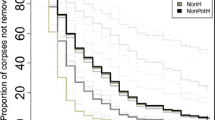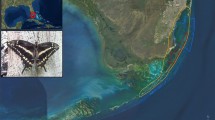Abstract
In order to decrease the risk of pathogen transmission, ants remove corpses from the vicinity of nests, but little is known about the underlying mechanisms. In particular, it is unclear how the odor profile of corpses changes with time since death and how any changes might relate to behavior. We have addressed these questions in the red ant Myrmica rubra, where we asked how the time since death determines the ability of workers to discriminate a dead individual from a live one, and whether dead workers are removed in a similar way when they originate from the same or an alien colony. We found that ants could discriminate alien from nestmate corpses up to 2 days after death, since the former continued to elicit aggressive behavior over that period. For dead nestmates, only 15 % of corpses were removed when freshly killed but this rises to 80 % for corpses between 1 to 6 days post mortem. Using gas chromatography, we found that oleic and linoleic acids, which are absent on freshly killed corpses, appeared post mortem and were in higher quantities on those corpses that were ejected from the nest vicinity. When added to fresh corpses, linoleic and oleic acids, alone or blended, enhanced removal to levels observed for corpses of 2–6 days post-mortem. Thus, oleic and linoleic acids appear to be important cues involved in corpse recognition and necrophoresis over a long timeframe, and we advance the hypothesis that these fatty acids in combination with other cues may also trigger other behaviors such as prey retrieval.






Similar content being viewed by others
References
Akino T, Yamaoka R (1996) Origin of oleic acid : corpse recognition signal in the ant. Formica japonica Motschlsky (Hymenoptera : Formicidae). Jpn J Appl Entomol Zool 40:265–271
Bankova VS, de Castro SL, Marcucci MC (2000) Propolis: recent advances in chemistry and plant origin. Apidologie 31:14. doi:10.1051/apido:2000102
Bos N, Lefèvre T, Jensen AB, D’ettorre P (2012) Sick ants become unsociable. J Evol Biol 25:342–351. doi:10.1111/j.1420-9101.2011.02425.x
Brandstaetter A, Endler A, Kleineidam C (2008) Nestmate recognition in ants is possible without tactile interaction. Naturwissenschaften 95:601–608. doi:10.1007/s00114-008-0360-5
Brew CR, O’Dowd DJ, Rae ID (1989) Seed dispersal by ants: behaviour-releasing compounds in elaiosomes. Oecologia 80:490–497. doi:10.1007/BF00380071
Brian MV (1973) Caste control through worker attack in the ant Myrmica. Insect Soc 20:87–102. doi:10.1007/BF02223340
Cavill GWK, Clark DV, Howden MEH, Wyllie SG (1970) Hydrocarbon and other lipid constituents of the bull ant, Myrmecia gulosa. J Insect Physiol 16:1721–1728. doi:10.1016/0022-1910(70)90271-4
Chapuisat M, Oppliger A, Magliano P, Christe P (2007) Wood ants use resin to protect themselves against pathogens. Proc Biol Sci 274:2013–2017. doi:10.1098/rspb.2007.0531
Choe D-H, Millar JG, Rust MK (2009) Chemical signals associated with life inhibit necrophoresis in Argentine ants. Proc Natl Acad Sci U S A 106:8251–8255. doi:10.1073/pnas.0901270106
Chouvenc T, Su N-Y (2012) When subterranean termites challenge the rules of fungal epizootics. PLoS ONE 7:e34484. doi:10.1371/journal.pone.0034484
Chouvenc T, Robert A, Sémon E, Bordereau C (2012) Burial behaviour by dealates of the termite Pseudacanthotermes spiniger (Termitidae, Macrotermitinae) induced by chemical signals from termite corpses. Insect Soc 59:119–125. doi:10.1007/s00040-011-0197-3
Cremer S, Armitage SAO, Schmid-Hempel P (2007) Social immunity. Curr Biol 17:693–702. doi:10.1016/j.cub.2007.06.008
Crosland M, Lok C, Wong T et al (1997) Division of labour in a lower termite: the majority of tasks are performed by older workers. Anim Behav 54:999–1012
Dani FR, Cannoni S, Turillazzi S, David Morgan E (1996) Ant repellent effect of the sternal gland secretion Polistes dominulus (Christ) and P. sulcifer (Zimmermann). (Hymenoptera: Vespidae). J Chem Ecol 22:37–48. doi:10.1007/BF02040198
D’ Ettore P, Lenoir A (2009) Nestmate recognition. In: Lach L, Parr C, Abbott K (eds) Ant ecology. Oxford University Press, New York
Diez L, Deneubourg J-L, Hoebeke L, Detrain C (2011) Orientation in corpse-carrying ants: memory or chemical cues? Anim Behav 81:1171–1176. doi:10.1016/j.anbehav.2011.02.026
Diez L, Deneubourg J-L, Detrain C (2012) Social prophylaxis through distant corpse removal in ants. Naturwissenschaften 99:833–842. doi:10.1007/s00114-012-0965-6
Drees BM, Miller RW, Vinson BS, Georgis R (1992) Susceptibility and behavioral response of red imported fire ant (Hymenoptera: Formicidae) to selected entomogenous nematodes (Rhabditida: Steinernematidae Heterorhabditidae). J Econ Entomol 85:365–370
Elmes GW (1973) Observations on the density of queens in natural colonies of Myrmica rubra L. (Hymenoptera: Formicidae). J Anim Ecol 42:761–771
Errard C, Hefetz A (1997) Label familiarity and discriminatory ability of ants reared in mixed groups. Insect Soc 44:189–198. doi:10.1007/s000400050040
Fan Y, Pereira RM, Kilic E et al (2012) Pyrokinin β-neuropeptide affects necrophoretic behavior in fire ants (S. invicta), and expression of β-NP in a mycoinsecticide increases its virulence. PLoS ONE 7:e26924
Franks N, Blum M, Smith R-K, Allies AB (1990) Behavior and chemical disguise of cuckoo ant Leptothorax kutteri in relation to its host Leptothorax acervorum. J Chem Ecol 16:1431–1444. doi:10.1007/BF01014079
Garnas JR, Drummond FA, Groden E (2007) Intercolony aggression within and among local populations of the invasive ant, Myrmica rubra (Hymenoptera: Formicidae), in coastal Maine. Environ Entomol 36:105–113. doi:10.1603/0046-225X(2007)36[105:IAWAAL]2.0.CO;2
Gilby AR (1965) Lipids and their metabolism in insects. Annu Rev Entomol 10:141–160. doi:10.1146/annurev.en.10.010165.001041
Gordon DM (1983) Dependence of necrophoric response to oleic acid on social context in the ant Pogonomyrmex badius. J Chem Ecol 9:105–111. doi:10.1007/BF00987774
Greene MJ, Pinter-Wollman N, Gordon DM (2013) Interactions with combined chemical cues inform harvester ant foragers’ decisions to leave the nest in search of food. PLoS ONE 8:e52219. doi:10.1371/journal.pone.0052219
Hart AG, Ratnieks FLW (2002) Waste management in the leaf-cutting ant Atta colombica. Behav Ecol 13:224–231. doi:10.1093/beheco/13.2.224
Haskins CP, Haskins EF (1974) Notes on necrophoric behavior in the archaic ant Myrmecia Vindex (Formicidae: Myrmeciinae). Psyche 81:258–267. doi:10.1155/1974/80395
Heinze J, Walter B (2010) Moribund ants leave their nests to die in social isolation. Curr Biol 20:249–252. doi:10.1016/j.cub.2009.12.031
Howard DF, Tschinkel WR (1976) Aspects of necrophoric behavior in the red imported fire ant, Solenopsis invicta. Behaviour 56:157–180
Lenoir A, Depickère S, Devers S et al (2009) Hydrocarbons in the ant Lasius niger: from the cuticle to the nest and home range marking. J Chem Ecol 35:913–921. doi:10.1007/s10886-009-9669-6
Liebig J, Peeters C, Oldham NJ et al (2000) Are variations in cuticular hydrocarbons of queens and workers a reliable signal of fertility in the ant Harpegnathos saltator? Proc Natl Acad Sci U S A 97:4124–4131. doi:10.1073/pnas.97.8.4124
Lockey KH (1988) Lipids of the insect cuticle: origin, composition and function. Comp Biochem Physiol B 89:595–645. doi:10.1016/0305-0491(88)90305-7
López-Riquelme GO, Malo EA, Cruz-LóPez L, Fanjul-Moles ML (2006) Antennal olfactory sensitivity in response to task-related odours of three castes of the ant Atta mexicana (Hymenoptera: Formicidae). Physiol Entomol 31:353–360. doi:10.1111/j.1365-3032.2006.00526.x
Marshall DL, Beattie AJ, Bollenbacher WE (1979) Evidence for diglycerides as attractants in an ant-seed interaction. J Chem Ecol 5:335–344. doi:10.1007/BF00987919
Martin S, Drijfhout F (2009) A review of ant cuticular hydrocarbons. J Chem Ecol 35:1151–1161. doi:10.1007/s10886-009-9695-4
Martin C, Provost E, Bagneres A-G et al (2002) Potential mechanism for detection by Apis mellifera of the parasitic mite Varroa destructor inside sealed brood cells. Physiol Entomol 27:175–188. doi:10.1046/j.1365-3032.2002.00284.x
Pfeiffer M, Huttenlocher H, Ayasse M (2010) Myrmecochorous plants use chemical mimicry to cheat seed-dispersing ants. Funct Ecol 24:545–555. doi:10.1111/j.1365-2435.2009.01661.x
Renucci M, Tirard A, Provost E (2010) Complex undertaking behavior in Temnothorax lichtensteini ant colonies: from corpse-burying behavior to necrophoric behavior. Insect Soc 58:9–16. doi:10.1007/s00040-010-0109-y
Ribeiro PL, Navas CA (2007) The leaf-cutting ant Atta Sexdens rubropilosa, FOREL, 1908 prefers drier chambers for garbage disposal. J Insect Behav 20:19–24. doi:10.1007/s10905-006-9052-1
Rollo CD, Czvzewska E, Borden JH (1994) Fatty acid necromones for cockroaches. Naturwissenschaften 81:409–410. doi:10.1007/BF01132695
Schmid-Hempel P (2005) Evolutionary ecology of insect immune defenses. Annu Rev Entomol 50:529–551. doi:10.1146/annurev.ento.50.071803.130420
Skidmore BA, Heithaus ER (1988) Lipid cues for seed-carrying by ants Hepatica americana. J Chem Ecol 14:2185–2196. doi:10.1007/BF01014024
Ugelvig LV, Kronauer DJC, Schrempf A et al (2010) Rapid anti-pathogen response in ant societies relies on high genetic diversity. Proc R Soc B 277:2821–2828. doi:10.1098/rspb.2010.0644
Ulyshen M, Shelton T (2012) Evidence of cue synergism in termite corpse response behavior. Naturwissenschaften 99:89–93. doi:10.1007/s00114-011-0871-3
Vander Meer R (2012) Ant interactions with soil organisms and associated semiochemicals. J Chem Ecol 38:728–745. doi:10.1007/s10886-012-0140-8
Visscher PK (1983) The honey bee way of death: Necrophoric behaviour in Apis mellifera colonies. Anim Behav 31:1070–1076. doi:10.1016/S0003-3472(83)80014-1
Wilson EO (1971) The Insect societies. Harvard University Press, Cambridge
Wilson EO, Durlach N, Roth L (1958) Chemical releasers of necrophoric behaviour in ants. Psyche 65:108–114
Acknowledgments
We thank Dr. J-C de Biseau and Laurent Grumiau for help and advice with compound identification using GC/MS analyses. We thank Paul Graham for helpful comments on the manuscript. This study was funded by a PhD grant from FRIA (Fonds pour la Recherche dans l’Industrie et dans l’Agriculture) and the Fonds David at Alice van Buuren. C.D. is a senior research associate from the Belgian National Fund for Scientific Research (F.N.R.S.).
Author information
Authors and Affiliations
Corresponding author
Rights and permissions
About this article
Cite this article
Diez, L., Moquet, L. & Detrain, C. Post-mortem Changes in Chemical Profile and their Influence on Corpse Removal in Ants. J Chem Ecol 39, 1424–1432 (2013). https://doi.org/10.1007/s10886-013-0365-1
Received:
Revised:
Accepted:
Published:
Issue Date:
DOI: https://doi.org/10.1007/s10886-013-0365-1




